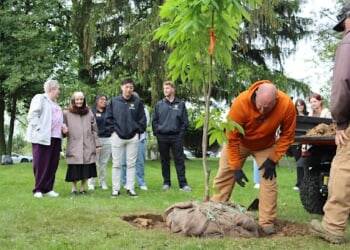The “Collaborative Combat Aircraft” drone program doesn’t quite stir the imagination as other, more famous aircraft have—but it is still integral to the cutting-edge NGAD system.
The U.S. Air Force has chosen to locate its first “Aircraft Readiness Unit” for the forthcoming drone wingmen, or “Collaborative Combat Aircraft” (CCA), at Beale Air Force Base in northern California. The CCA, which is expected to accompany the F-47 NGAD sixth-generation fighter, has begun ground testing in preparation for a first test flight, scheduled for this summer.
“Starting ground tests is a key milestone for the CCA Increment 1 program,” said General David Allvin, Air Force Chief of Staff. “This phase bridges the gap between design and flight, reducing integration risks, boosting confidence, and laying the groundwork for a successful first flight and eventual fielding to the warfighter.”
Testing the New Drone Wingmen at Beale Air Force Base
The Aircraft Readiness Unit, stationed at Beale AFB, will “provide combat aircraft ready to deploy worldwide at a moment’s notice,” according to the Air Force. Accordingly, the CCA is expected to “fly a significant number of daily sorties to maintain readiness.”
But all that comes later. Right now, ground testing is underway, which “includes rigorous evaluations” of the CCA’s “propulsion systems, avionics, autonomy integration, and ground control interfaces.” The testing is designed to “validate performance, inform future design decisions, and prepare the systems for flight testing later this year.”
The CCA program will join a long-line of prominent programs to be based from Beale AFB, which is somewhat isolated to the north of Sacramento. Previously, the famed SR-71 Blackbird operated from Beale. At present—albeit not for much longer—the base is also home to the legendary U-2 Dragon Lady. Both the SR-71 and U-2 are Cold War-era reconnaissance aircraft that are designed to fly in the upper reaches of the Earth’s atmosphere. Moreover, both aircraft were, at their inception, ultra-sensitive and packed with novel technologies.
The CCA program doesn’t quite stir the imagination, or a sense of romanticism, in the way that the SR-71 or U-2 have. Still, the program is integral to the NGAD system, which is at the very cutting edge of aviation technology and a harbinger of the automated/remote-operated future of aviation that surely awaits.
All About the CCA Drone Program
The CCA program currently consists of two separate airframes, the General Atomics YFQ-42A, and the Anduril YFQ-44A. “At least one of the prototypes is expected to head into production for the program’s first tranche or “increment,” although other firms are also able to compete for the opportunity,” Breaking Defense reported. “A separate pool of vendors is competing to develop the autonomous software that will pilot the drones, although that competition is classified.”
The Air Force hopes to field an operational CCA platform before the end of the decade, allowing advanced fighters like the F-35 and F-47 to operate with a dedicated “wingman.”
Both General Atomics and Anduril have said that their respective programs are on schedule.
“We remain on schedule to test and fly YFQ-42 in the coming months,” General Atomics President Dave Alexander said.
Anduril Senior Vice President Jason Levin concurred: “We continue to work tirelessly…to ensure that we deliver the capability that our warfighters deserve.”
About the Author: Harrison Kass
Harrison Kass is a senior defense and national security writer with over 1,000 total pieces on issues involving global affairs. An attorney, pilot, guitarist, and minor pro hockey player, Harrison joined the U.S. Air Force as a Pilot Trainee but was medically discharged. Harrison holds a BA from Lake Forest College, a JD from the University of Oregon, and an MA from New York University. Harrison listens to Dokken.
Image: Wikimedia Commons.

















